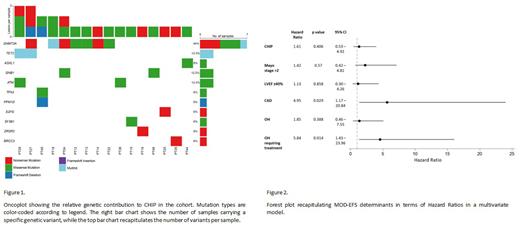Backgrounds: AL Amyloidosis is a plasma cell dyscrasia whose hallmark is the circulation and deposition of immunoglobulin free light chains in target organs. The extent and severity of cardiac involvement are the primary determinants of mortality in AL amyloidosis. Patients harboring clonal hematopoiesis of indeterminate potential (CHIP) have an increased cardiovascular risk compared to the general population. In the setting of multiple myeloma receiving autologous stem cell transplants, CHIP presence has been associated with decreased overall survival. Still, large studies looking at the incidence and outcome of patients with concurrent CHIP and AL amyloidosis are missing. Herby, we present the results of a single-center, retrospective cohort study, where we assessed the prevalence of CHIP in AL amyloidosis and associated disease characteristics and outcomes.
Methods: We collected the demographics and clinical characteristics of patients with AL amyloidosis at Dana Farber Cancer Institute (DFCI) from January 2018 to April 2023 who underwent a bone marrow aspirate/biopsy with a rapid heme panel. Variables of interest included age, ethnicity, Mayo 2004 stage, Palladini renal stage, involved organs, FISH abnormalities, left ventricular ejection fraction (LVEF), documented coronary artery disease (CAD), orthostatic hypotension (OH), chemotherapy (CT) treatment received and related response. The primary outcome was major organ dysfunction progression-free survival (MOD-PFS), defined by Kastritis et al. The variant allele fraction (VAF) to define CHIP was set at 2%. Two samples t-test, Wilcoxon rank sum test, and Fisher's exact test were used to compare groups. Univariate and stratified multivariate Cox proportional hazard regression models were used to estimate the association between CHIP status and MOD-PFS. Analyses were carried out with the Stata statistical package. This study was approved by the DFCI Institutional Review Board and performed in accordance with the Declaration of Helsinki.
Results: We identified 76 patients as meeting the inclusion criteria. The median age was 67 years. FISH was available for 54 patients. All patients received cytoreductive CT (CyborD 47%, DaraCyborD 37%). CHIP was identified in 16 patients (21%), a significantly higher figure as compared to historical age-matched healthy controls. DNMT3A was the most frequently involved gene (7/16, 44%), followed by GNB1, TET2, ATM (each 2/16, 12.5%), and SF3B1, ZRSR2, EZH2, BRCC3, PPM1D, ASXL1 (6%) (Figure 1). The presence of CHIP strongly associated with t(11;14) (11/13, 85% in patients with CHIP, versus 15/41, 37%, in patients without CHIP, p=0.004) and with a lower Palladini renal stage in patients with renal involvement (p=0.001). The median follow-up time for the entire cohort was 25 months (range 1 - 175 months). In a univariate analysis, CHIP presence was not associated with lower MOD-PFS (hazard ratio [HR] 0.998, 95% CI 0.38 - 2.64). In a univariate analysis, a Mayo stage >2 (HR 4.82, 95% CI 1.95 - 11.91, p = 0.001), the presence of CAD (HR 4.97, 95% CI 1.79 - 13.79, p=0.02), LVEF ≤40% (HR 3.18, 95% CI 1.17 - 8.66, p = 0.023), and OH requiring treatment (HR 2.65, 95% CI 1.74 - 5.97, p = 0.019) were associated with a decreased MOD-PFS. In a multivariate model stratified for age, only the presence of CAD and OH requiring treatment remained associated with worse MOD-PFS (HR 5.65, 95% CI, 1.33 - 23.99, p = 0.019; HR 4.57, 95% CI, 1.30 - 16.05, p = 0.018, respectively). In the multivariate Cox regression model (Figure 2), CHIP presence was not associated with a decreased MOD-PFS (HR 1.32, 95% CI, 0.44 - 3.98, p = 0.624). When focusing on the impact of only DNMT3A, a tendency towards a statistically significant association with worse MOD-PFS was noted in the multivariate model (HR 3.72, 95% CI 0.92 - 15.01, p = 0.065).
Conclusion: We present the largest dataset exploring the prevalence of CHIP in AL amyloidosis patients and its clinical correlates. We noted an association between the presence of CHIP and t(11;14), the most frequent cytogenetic abnormality in AL amyloidosis, and adverse prognostic factors. Patients with CHIP were also found to have a lower Palladini renal risk score. Harboring CHIP was not associated with worse MOD-PFS; however, DNMT3A mutation tended to correlate with worse MOD-PFS. Larger prospective studies are warranted to validate these findings and better elucidate the impact of CHIP in patients with AL amyloidosis.
Disclosures
No relevant conflicts of interest to declare.


This feature is available to Subscribers Only
Sign In or Create an Account Close Modal